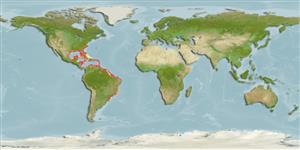Teleostei (teleosts) >
Mulliformes (Goatfishes) >
Mullidae (Goatfishes)
Etymology: Upeneus: Greek, ypene, -es = upper lip (Ref. 45335).
More on author: Poey.
Environment: milieu / climate zone / depth range / distribution range
Ecology
Marine; demersal; depth range 18 - 100 m (Ref. 5217), usually 40 - 70 m (Ref. 9626). Tropical; 37°N - 33°S, 98°W - 34°W
Western Atlantic: North Carolina, USA and Puerto Rico to Santa Catarina, Brazil (Ref. 57756). Absent in the Bahamas, Bermuda, and the western Caribbean (Ref. 26938).
Length at first maturity / Size / Weight / Age
Maturity: Lm 14.6 range ? - ? cm
Max length : 30.0 cm TL male/unsexed; (Ref. 26938); common length : 20.0 cm TL male/unsexed; (Ref. 3792); max. published weight: 180.00 g (Ref. 126891)
Found over mud and sand bottoms (Ref. 3792). Juveniles up to 8 cm are pelagic (Ref. 9626). Feeds mainly on benthic invertebrates (Ref. 3792). Flesh considered good quality; marketed fresh and frozen (Ref. 3792). In southwestern Brazil found in 112 m depth (Ref. 47377).
Life cycle and mating behavior
Maturities | Reproduction | Spawnings | Egg(s) | Fecundities | Larvae
Robins, C.R. and G.C. Ray, 1986. A field guide to Atlantic coast fishes of North America. Houghton Mifflin Company, Boston, U.S.A. 354 p. (Ref. 7251)
IUCN Red List Status (Ref. 130435)
Threat to humans
Harmless
Human uses
Fisheries: commercial
Tools
Special reports
Download XML
Internet sources
Estimates based on models
Preferred temperature (Ref.
123201): 19.5 - 27.3, mean 24.5 °C (based on 127 cells).
Phylogenetic diversity index (Ref.
82804): PD
50 = 0.5000 [Uniqueness, from 0.5 = low to 2.0 = high].
Bayesian length-weight: a=0.00955 (0.00806 - 0.01131), b=3.11 (3.08 - 3.14), in cm total length, based on LWR estimates for this species (Ref.
93245).
Trophic level (Ref.
69278): 3.9 ±0.7 se; based on diet studies.
Generation time: 3.1 ( na - na) years. Estimated as median ln(3)/K based on 1
growth studies.
Resilience (Ref.
120179): Medium, minimum population doubling time 1.4 - 4.4 years (Preliminary K or Fecundity.).
Fishing Vulnerability (Ref.
59153): Low to moderate vulnerability (31 of 100).
Nutrients (Ref.
124155): Calcium = 157 [89, 302] mg/100g; Iron = 1 [0, 2] mg/100g; Protein = 17.4 [15.4, 19.7] %; Omega3 = 0.291 [0.165, 0.535] g/100g; Selenium = 53.4 [28.0, 103.4] μg/100g; VitaminA = 27 [9, 94] μg/100g; Zinc = 1.07 [0.66, 1.52] mg/100g (wet weight); based on
nutrient studies.
